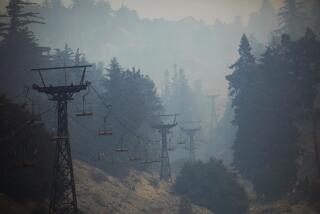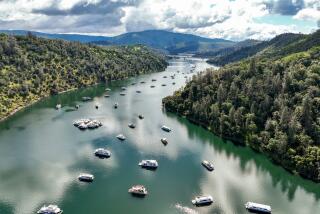WEEKEND : A Winter Wonderland for Big Bear Skiers
When life gave lemons to ski resort owners near Big Bear Lake, they didn’t just pucker up and quit. Instead, they made lemonade--out of man-made snow.
The result? In these days of drought, Snow Summit and Bear Mountain ski resorts can truthfully boast, “come on up, the skiing’s great.”
With natural snowfall virtually non-existent, various area ski resorts either have closed or snow-making is down to a minimum. But Snow Summit and Bear Mountain in the San Bernardino Mountains are in full swing, thanks to water drawn from Big Bear Lake and to ski industry people who in the 1960s recognized that with Southern California’s arid climate, you can’t count your snowflakes before they fall.
“The psychology of skiing is mixed,” said Monica Bandows, a spokeswoman at Bear Mountain. “With the conditions the way they are in the rest of the state we should be packed every day, but we’re not. The perception is that when it’s warm down the hill there’s no snow up here, and that’s far from the truth.”
Snow-making wasn’t always as smooth as it is today.
In the first days, clumsy efforts to duplicate nature were as likely to produce wet slush as bone-crunching ice. But today, the results are more like genuine packed powder. Nowadays, man-made snow--the result of compressed air and water pumped up from Big Bear Lake to hydrants along the ski runs, then shot from guns like puffed rice--looks like the real thing, skis like the real thing and slides down wet and icy inside your boot tops like the real thing.
“I like this snow. It’s fast, it’s great spring skiing,” said Jeb Lipson as he boarded Bear Mountain’s new high-speed quad lift for the six-minute ride to the top of 8,440-foot Goldmine Mountain. Bear Mountain installed the $2.5 million lift this winter.
Lipson, a musician from Hollywood, said he was thrilled with the blue sky, hot sun and the short lift lines typical of midweek skiing. “After all, I could be sitting on the 405 (freeway) or running errands,” he said.
Jim Thompson and Dave Callaway, from Montclair, compared the snow to that at Utah and Colorado resorts they’ve skied in previous years. “We were expecting it to be slow, with bare spots, but everything’s covered,” said Callaway. At night, when the thermometer plummets below freezing, both resorts continue to make snow, adding new layers of light powder on top of a machine-groomed packed powder base. Bear Mountain reports a snow depth of 2 to 5 feet with trails on all four mountains open. Snow Summit also has 2 to 5 feet and all runs covered.
Still, this is a far cry from the days when ski resorts were nonchalant about having 15 feet of annual snowpack. This year’s snowfall is being measured in inches.
With the crippling drought in no sight of ending, some observers have wondered whether precious water ought to be wasted on a ski resort. According to Bandows, both the Sierra Club and Save Our Forests Assn., a local group, have formally raised the issue.
But ski resorts and most local businesses respond that snow-making is a closed system, with most of the water pumped out of the lake staying within the community.
“We did a study that showed at least 50% of the water that goes to the ski areas returns to the lake,” said Jere Mitchell, general manager of the Big Bear Municipal Water District, which manages the lake. “The rest evaporates or goes back into the water table and into local wells.” Without lake water--which is not used for drinking--the ski resorts would use well water, which “is sorely needed for domestic use,” said Mitchell.
How much water do the resorts use in a year? Their contracts state that each ski area can buy up to 500 acre feet of water in one year, or 162,946,000 gallons. Both resorts say they will pump more water than ever before this year, but aren’t even close to their limit.
“At the last tally, measured at the end of January, both had used a little over 300 acre feet,” said Mitchell.
One of the most innovative solutions to the drought has been proposed by Snow Valley ski resort, near Running Springs, which draws water from its own lake filled each spring by rain and snowmelt. Snow Valley has been hard hit by the drought and manages to stay open but only 40% of its runs are covered with a thin base of snow.
Next year Snow Valley and the Running Springs Water District will build a third-stage sewage treatment plant (which will produce drinkable water) and pipe it over to Snow Valley for snow-making.
Running Springs will pay to build the plant and Snow Valley will buy the water.
“That’ll give us enough water to be competitive,” says operations manager Paul Bauer, “but it will also put a lot of local well water back into the ground. The way it is now, that water runs down the hill in the sewer, and is gone forever.”
* Snow Summit Ski Resort is open daily and some evenings. Tickets go on sale at 7:30 a.m. The lifts start running at 8 a.m. On holidays and Saturdays lifts tickets may run out by 9 a.m. Tickets are $35.50 for adults, $28.50 on weekdays for ages 22 and under, $18 for ages under 12 and $28.50 for seniors. For general information, call (714) 866-5766. For recorded snow reports, call: (213) 613-0602, (818) 888-2233, (714) 972-0601, (714) 866-4621 or (619) 294-8786.
* Bear Mountain Ski Resort is open daily. On weekdays, tickets go on sale at 7:30 a.m. and the lifts open at 8 a.m. On weekends, tickets go on sale at 6:30 a.m. and the lifts open at 7:30 a.m. Tickets are $36 for adults, $26 for students with ID and $29 for firefighters, police officers, military and airline employees. Snowboarding available. For information, call (714) 585-2519. For recorded snow reports: (213) 289-0636, (714) 630-1141, (619) 238-5555 or (818) 764- 8888.
To get there: Both resorts are on the south shore of Big Bear Lake. From Los Angeles, Orange County and San Diego, take I-10 east to the Orange Street Exit (Redlands), then Highway 38 to Big Bear Lake. From the San Fernando Valley, take I-15 through Cajon Pass to Bear Valley Road, then Highway 18 to Big Bear Lake.
More to Read
Sign up for The Wild
We’ll help you find the best places to hike, bike and run, as well as the perfect silent spots for meditation and yoga.
You may occasionally receive promotional content from the Los Angeles Times.






